Artists
Painter Louise Giovanelli Finds Inspiration for Her Deconstructed Canvases at a Minimalist Residency in Mallorca
We visited the artist-in-residence at Neuendorf House in Mallorca.
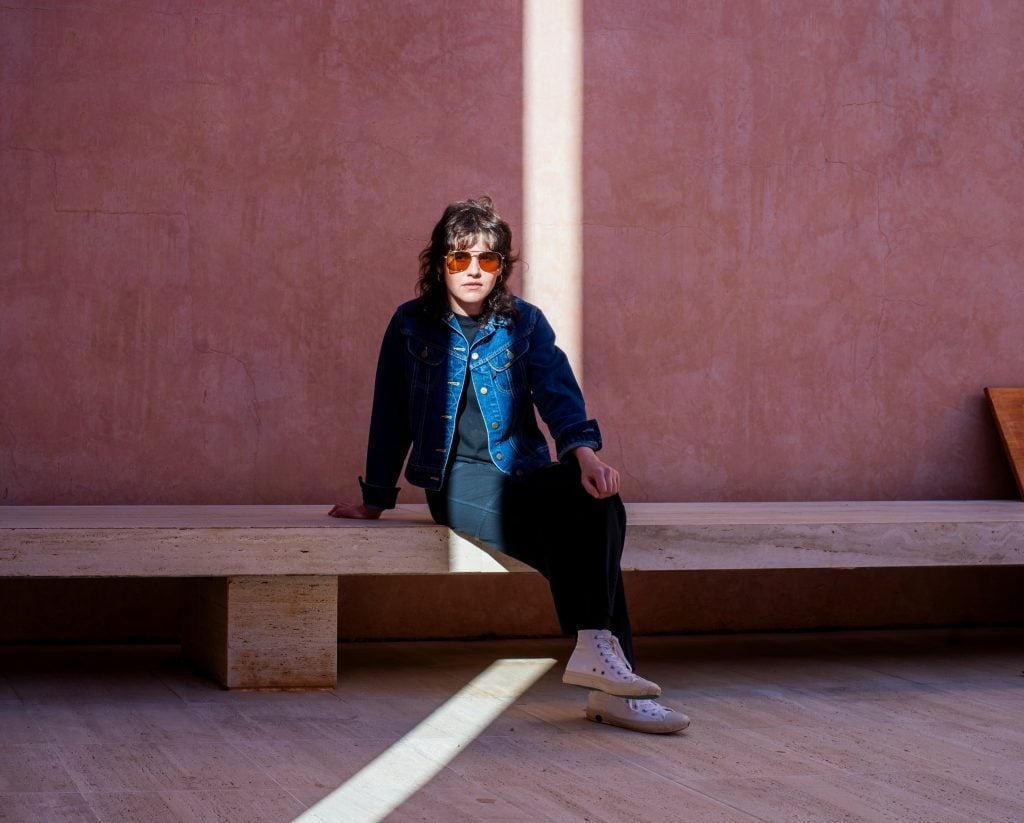
We visited the artist-in-residence at Neuendorf House in Mallorca.

Jo Lawson-Tancred

Stage curtains are never simply two hanging drapes. They come loaded with expectation about what lies beyond, the universal teaser for a big reveal. To see them made the subject of epic paintings by the British painter Louise Giovanelli is immediately surprising and unsettling. The artist is celebrated for radiantly textural paintings like these, which lure us with the promise of a spectacle but never yield, thrusting us into a state of eternal suspense.
Befitting the drama of her artwork, I met Giovanelli when she was setting up her easel at the center of a walled courtyard under the stark shadows of an imposing edifice in Mallorca. Transplanted from her Manchester studio in an old tram depot, the painter had taken up residency at the magnificently austere setting of Neuendorf House. Designed for the German art dealer and Artnet founder Hans Neuendorf and his wife Caroline in the late 1980s by architects John Pawson and Claudio Silverstrin, its exterior is articulated without embellishment, rising like a monolith amid a lusciously verdant landscape. Its slightly surreal character seemed straight out of one of the many niche cinematic thrillers that Giovanelli name-dropped throughout our conversation.
By her own account, Giovanelli’s paintings succeed if we walk away with an unplaceable sense of uneasiness. “Not to be able to peer through [the curtains] but to have them like a blockade is quite challenging,” she said. “I want to engender those psychologically charged in between states.”
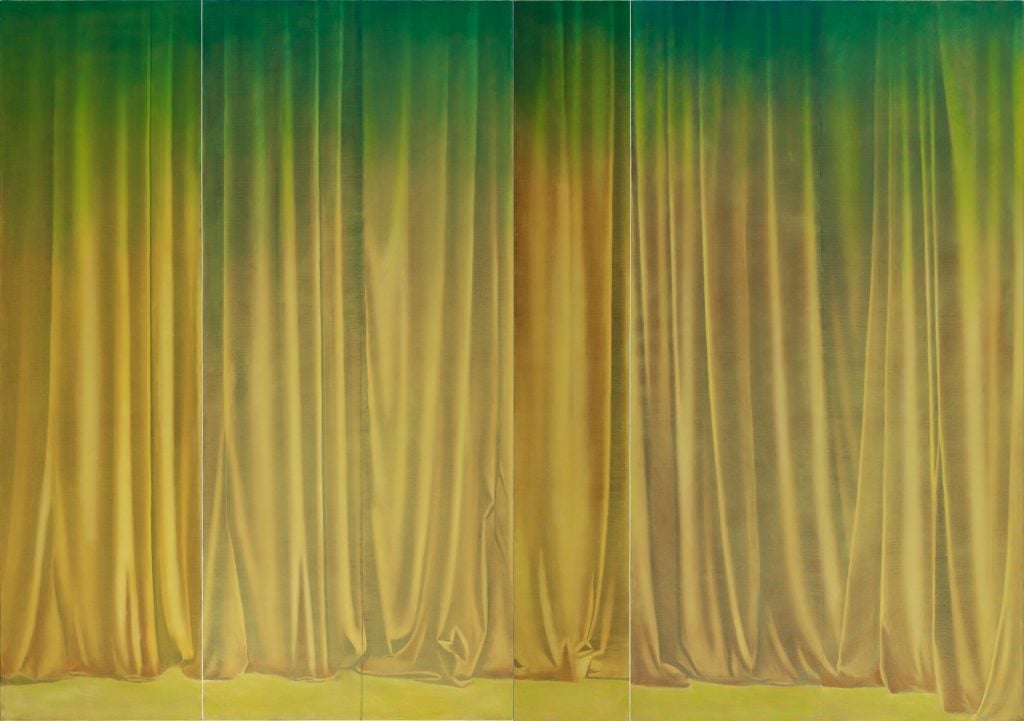
Louise Giovanelli, Prairie, (2021). Courtesy of Grimm Gallery.
Far from feeling alienated, however, collectors have been clamoring to acquire a Giovanelli since she began showing with Grimm Gallery in 2020. Four years later, she has shot to art stardom, is also represented by blue-chip gallery White Cube, and has works in the collections of several museums including the Tate in London, MOCA in Los Angeles, and ICA Miami.
Born in London in 1993 to an Italian father and an Irish mother, Giovanelli was raised in the small Welsh town of Monmouth. It wasn’t until she moved to Manchester for her B.A. in Fine Art that she gained access to galleries and museums for the first time and began travelling to major collections across Europe. The Northern Renaissance in particular has “gone in very deep in my psyche,” she said. She used her phone to capture eye-catching details from Old Master paintings to be recreated at home. Now, “the crop is one of the anchoring parts of my practice,” she said, and her art historical references have taken on a crudely filtered, intentionally oversaturated post-internet flair.
Giovanelli’s avaricious eye is always roving for the next split second still to transfer onto canvas. Found images that interest her go into a folder on her phone known as “The Album.” “I just dump everything there and scroll through it every couple of days,” she explained. “It’s like my brain.” Her solo show “As If, Almost” at White Cube in London in 2022 was filled with wine glasses inspired by the same item so often in the clutches of Joanna Lumley’s Patsy from the BBC’s Ab Fab. In the painting Auto-da-fé (2021), fans of horror will recognize Sissy Spacek’s titular character from Carrie (1976), still overjoyed at having just been named prom queen. It is no coincidence that this scene is forever charged with the anticipation of disasters yet to come.
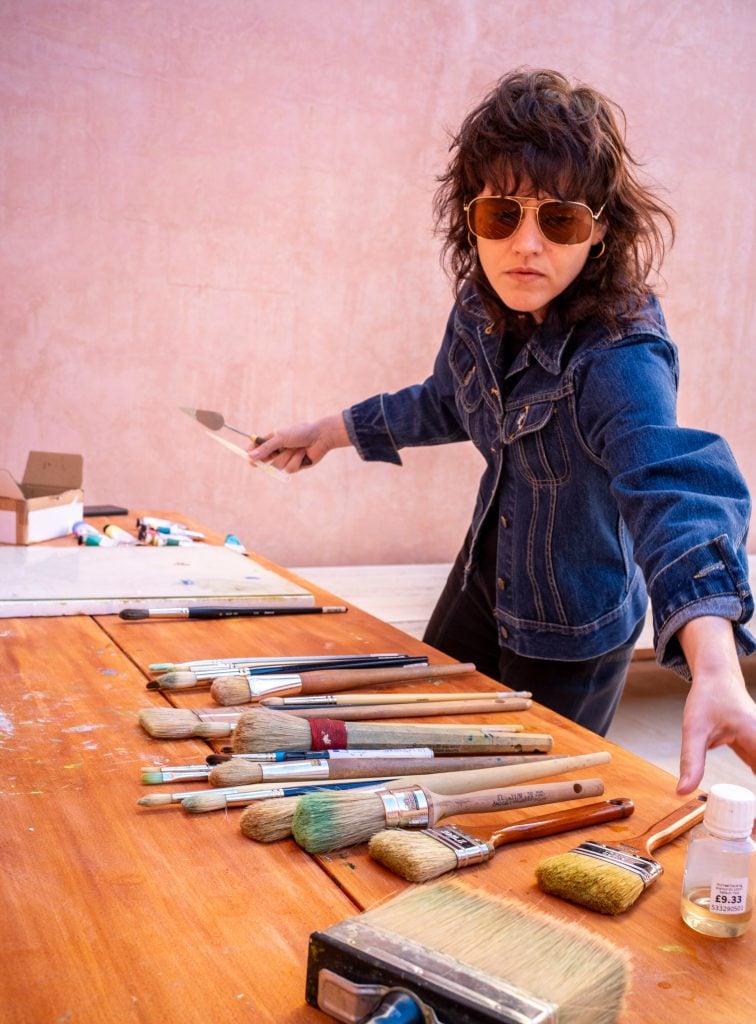
Louise Giovanelli in the courtyard of Neuendorf House in Mallorca, Spain. Photo: Bruno Daureo.
Giovanelli came to find her style a couple of years after leaving the Manchester School of Art in 2015, completing an M.A. under the American artist Amy Silman at the Städelschule in Frankfurt, Germany. There she had more freedom than is typical of the U.K.’s assessment-based university system, and plenty of state funding for class trips, but she was also taken aback by the “cynical attitude” of her peers.
“Some students would just be posing, not making work and thinking that that somehow made them better than you,” she recalled. “It was like: ‘oh, you don’t need to learn how to paint. Let’s deconstruct everything! We’re so post-modern!'”
She tuned out the noise. “I sound like an old white man but there isn’t enough attention to technical skill in contemporary painting,” she lamented. The luminous quality for which her work is routinely praised is achieved by having the canvas’s white ground shine beneath thin glazes rather than coating on white paint. This is not a new idea. Giovanelli borrowed it from the historical greats, although that doesn’t mean she won’t innovate. Take the glittering veil that often shrouds her subjects, so that light not only illuminates but also dazzles and ultimately obscures. This is achieved by projecting the found image onto a canvas freshly covered in wet paint, making the surface sparkle. She paints from a photograph of the projection, thereby creating several layers of distortion. But of course, “you can only deconstruct things if you know how to construct them in the first place.”
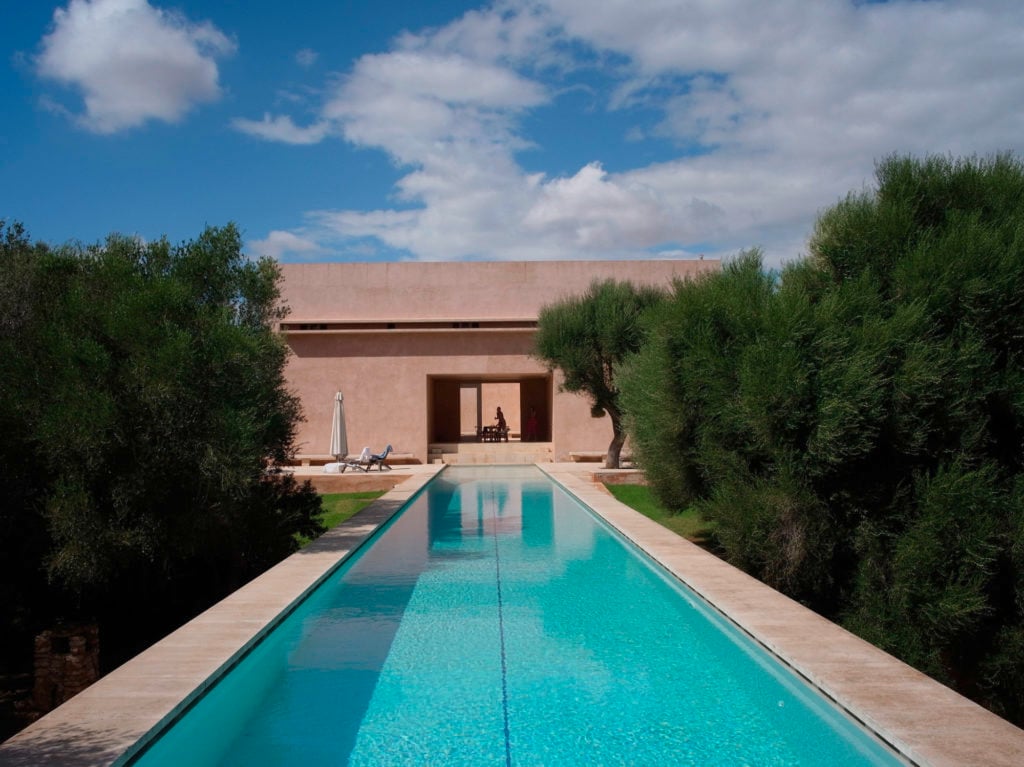
The Neuendorf House in Mallorca, designed by Pawson and Silvestrin. Courtesy of the Neuendorf House.
When I visited the artist at the tail end of her five-week winter residency, she admired the location’s rare tranquility. “Watching the day unfold… You don’t get that in a city. It’s like a kinetic sculpture.”
She explained how the passing of time was traced by shadows that stretched across the house’s terracotta walls, extinguishing the cadmium orange glow of the sun.
Glimpses of the getaway were shared with her 25,000 Instagram followers, in which she appears with huge sunglasses and a scruffy wolf cut amid photos of salty Padron peppers and legs sprawled on a beach. Behind the scenes, Giovanelli worked seven days a week, the 8 a.m. starts a lie-in compared to her usual 6 a.m. “It’s the only way to get things done, isn’t it?,” she shrugged. “Having time off I actually find quite stressful.” Although she presents as laid-back, this air of decisive efficiency is never far from the surface.
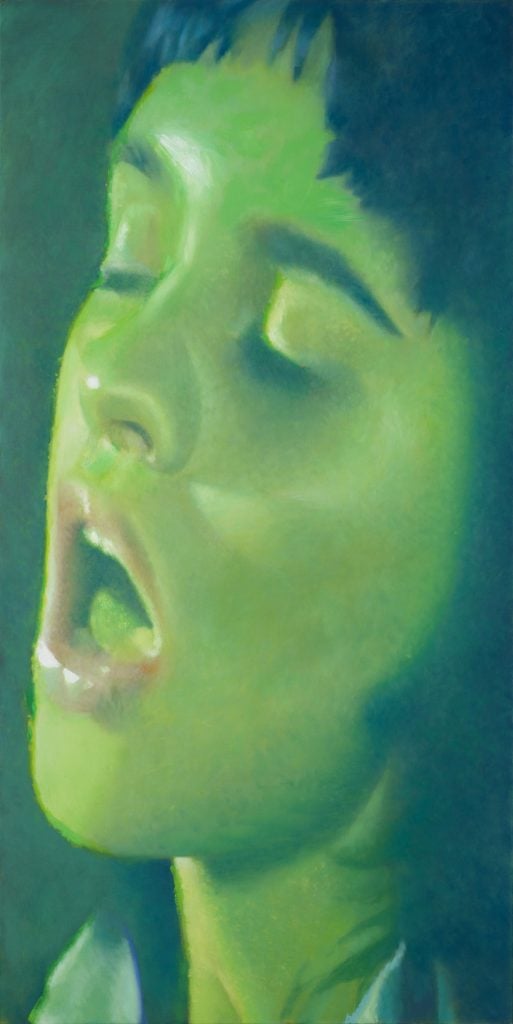
Louise Giovanelli, Entheogen (2023). Courtesy of Grimm Gallery.
And the commitment paid off. She showed me three new paintings that develop ideas from an earlier work, Entheogen (2023). Tinged with sickly green, that painting contains a young woman’s head tilted back with her eyes shut and lips parted. The image is tightly cropped, giving us no clues to explain her euphoria. As it happens, Giovanelli was inspired by a scene in which a girl receives the Eucharist from Alice, Sweet Alice (1976), a cult slasher movie about two sisters preparing for their first communion.
A search for similar imagery with which to continue the series left Giovanelli frustrated for months until she landed on vintage pornography from the 1970s. After all, viewers had already speculated about possible erotic undertones in Entheogen. “That one really is very innocent,” she said, “but obviously its provocative and it could be something more.”
The newer images would need more effort to be extracted from their original context, however. Maybe the woman’s cupped hands could be clutching a microphone, or even praying. Shimmering fluids could, perhaps, be the splash of holy water. There is something tantalizingly perverse in the notion that sublime states are universal enough to provoke the same expression in a pornstar as a Catholic nun. At least, it worked for the 17th century sculptor Bernini and his Ecstasy of Saint Theresa. Whether the experience was sacred, spiritual, carnal, or intoxicated, everyone has at one time surrendered to a wave of unrestrained rapture. By dispensing with detail, Giovanelli evokes something more elemental.
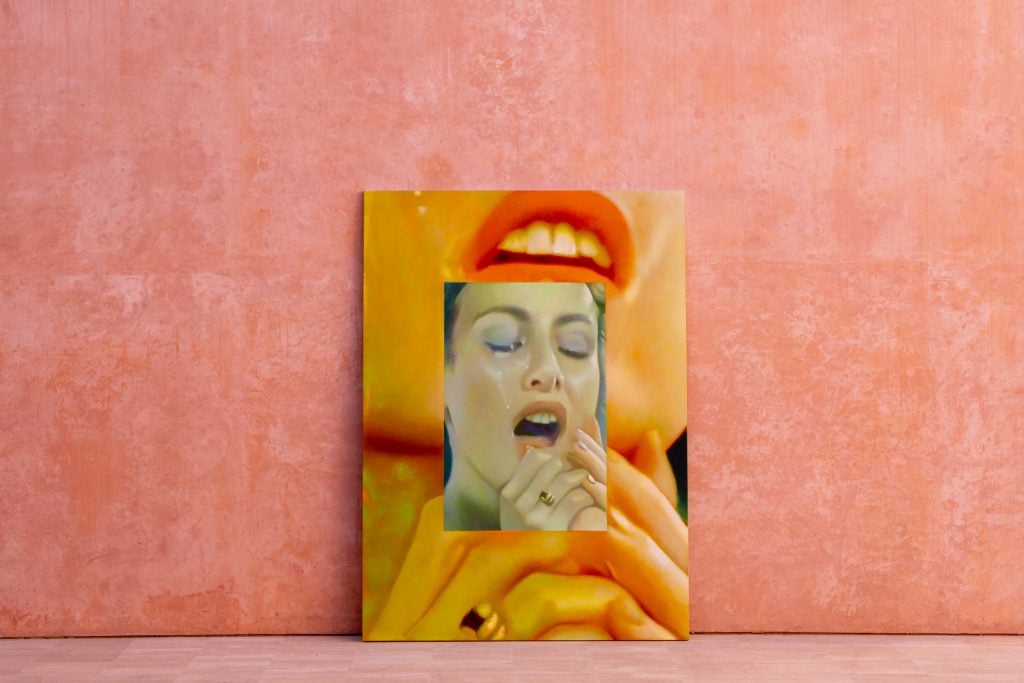
New work by Louise Giovanelli completed on the Neuendorf Residency in Mallorca, Spain. Photo: Bruno Daureo.
In these most recent works, Giovanelli aimed for a “more mottled, congested gray effect,” hoping it would emphasize the original footage’s richly grainy quality. Much of her work takes cultural references that would now be considered retro and further imbues them with a sense of faded glamor.
“I think its just my personality,” Giovanelli said of her preference for this style. “I’ve always felt throughout my life that I’ve just missed everything.” It has the effect of pulling the viewer out of the present moment and transporting them someplace unexpected. I couldn’t say why, but some of her paintings make me think of weddings recorded on VHS tapes or party scenes from The Godfather. This strangely nonspecific nostalgia recalls the fragmentary, ever elusive nature of memory and the labyrinth of chance associations sparked by certain aesthetics or “vibes.”
It is only once the stage curtains are up, that most people start paying attention. Not Giovanelli, who recognizes instead the irresistible uncertainty of a closed curtain. Counterintuitively, perhaps, its this knack for zooming in on one distinctive detail or transient visual effect that always captures a more macrocosmic truth.
Louise Giovanelli’s participation in the Neuendorf Residency was organized with the help of Grimm Gallery. The works made in Mallorca will be exhibited at White Cube in Hong Kong from March 26 through May 18. Giovanelli has upcoming solo shows at The Hepworth Wakefield in November 2024 and at Grimm Gallery in New York in May 2025.